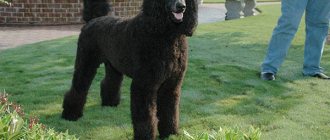Rottweilers are excellent protectors, good friends and excellent companions.
They can be serious and focused, or they can be playful and cute.
These dogs are very versatile, friendly and kind, but at the same time they are always ready to defend their beloved owner.
In this article we will talk about how many years Rottweilers live and what they need to please their owners for as long as possible.
physical characteristics
Rottweilers have a very powerful build - with a height at the withers of 60-70 centimeters, they can weigh more than 50 kilograms.
The dog's body is muscular, with a wide chest, limbs of medium length, the hind legs are very strong, semi-bent, giving impetus to the movement of the animal.
The head is medium in size with a short and strong muzzle.
The eyes are dark, almond-shaped, the look is intelligent, kind, and understanding.
The ears are small relative to the head, triangular in shape, hanging down.
The tail is docked at an early age.
The coat is coarse, dense, short.
Read more about what Rottweilers look like here.
Deviations from the standard
Defects
Any, even small, deviations from the standard can be counted as flaws. Each deviation is considered by the judges individually.
The following parameters are considered defects:
- poorly developed muscles of the dog’s trunk;
- non-standard physique: light or vice versa - too heavy;
- elongated or shortened muzzle;
- narrow or lightweight skull;
- poorly defined stop;
- saggy jowls;
- shaved without black pigmentation;
- narrow jaws;
- low set ears;
- erect position of the ears;
- eyes are not almond shaped;
- elongated or shortened neck;
- folds on the neck;
- narrow, long or vice versa – short body;
- uneven back line;
- strongly sloping croup;
- barrel-shaped chest;
- tail set low or too high;
- undeveloped muscles of the limbs;
- soft wool;
- too big sun spots.
Disqualifying faults
The defects that can permanently end a Rottweiler's exhibition career include the following deviations from standard parameters:
- a male behaves like a female and vice versa;
- cowardice;
- uncontrolled aggressiveness;
- shyness;
- unbalanced psyche;
- not brown eye color;
- eye diseases, such as cataracts or strabismus;
- not a scissor bite;
- incomplete set of teeth;
- coat is too long;
- curly hair or with a slight wave;
- non-standard color;
- white tan spots.
Share with us in the comments how old your dog is and how much it weighs. Does your pet meet the standard?
If you liked the article, please like it.
Character traits
Rottweilers have a lot of positive qualities, namely:
- loyalty;
- courage;
- obedience;
- learning ability;
- vigilance
- high intelligence;
- durability.
This breed becomes very attached to the family, especially to one owner, whom the animal itself chooses. The Rottweiler is good with children, especially if the animal and the child grew up together.
He can be aggressive and suspicious of strangers, but quickly gets used to people and changes his anger to mercy. In case of danger, the dog will stand up for its family and will protect it to the last.
A well-socialized animal will easily interact with other animals, but the other dog in the house will always be its competition.
IMPORTANT!
Rottweilers excel in training because they have amazing intelligence, but training should begin at an early age by someone who has experience working with dogs.
There is no point in punishing the dog; it is better to explain to it in a gentle but confident voice what is possible and what is not.
Training and education
Despite the fact that the Rottweiler belongs to the category of service dogs, their training requires serious effort and skill. It is better to raise a dog together with a specialist. For those who decide to train their pet on their own, it is advisable to take several lessons that will help you learn optimal communication with your dog.
The basic rules of behavior in the house must be instilled in the puppy, starting from the first day. They must be carried out unquestioningly and be consistent. Rottweilers are very smart, independent, and self-confident. They will only obey a person they respect. Moreover, often the puppy chooses its owner for itself. The dogs perceive the rest of the family members as needing care; they do not have authority.
First of all, your pet needs to be taught to sleep in its place. In order for the puppy to quickly learn to go to the toilet on the street, it is worth taking him out for a walk immediately after eating, encouraging the baby for urinating outside the home.
After all the vaccinations, you need to walk your Rottweiler as much as possible and practice the “come to me” command. It is intended not only to call the animal - it is a way to control the pet when it is at a distance from the owner. This ensures the safety of others and the dog himself. You need to call him by name several times, repeating the order. For completing a task, the dog must be praised and given a treat every time.
They begin to master the “sit” command before eating. When the baby sits in front of the bowl on his own, you should practice the skill outside.
Another important command is “fu”, which cancels any unwanted actions of the pet. The orders “no” and “quit” have a similar meaning. The latter is relevant in situations where the dog is trying to eat something while walking.
Breeders note that the reaction of Rottweilers is somewhat slow. They take longer to analyze the command and take action than other breeds. You can’t rush; you need to master skills gradually moving from one task to another. You cannot give several commands at the same time - the dog will get confused.
But once a Rottweiler masters a skill, he will not forget it throughout his life. After mastering the basic training course, you can begin SKD.
Attention: representatives of this breed do not forgive violence!
Dogs are cunning and vindictive, so you can’t physically punish them, but you shouldn’t baby them either. This is a serious dog that requires firmness. Thanks to their developed intelligence, they respond well to intonation and love their owner. They will obey in order to please the owner and receive praise.
Reviews
Larisa, 37 years old, Voronezh
“My girl lived for 17 years. Long-lived by Rottweiler standards. Wonderful friend. I adored children. They ate ice cream together. She could sometimes growl when she was pushed too hard. But she never bit, even lightly. The only trouble was that it stained the wallpaper. If it rubs against a light wall, black spots remain. Otherwise there are only positives. A huge, kind, reliable dog.”
Darina, 27 years old, Ufa
“My parents had a male Uranus. Huge Rottweiler. We all loved him madly. Unfortunately, he lived only 7 years. The cause of death was a heart attack. Completely our fault. His parents loved to pamper him - dumplings, cookies, sweets, various goodies... Of course, he gained weight catastrophically. Despite walking twice a day, it increased. He was child friendly. He endured the Kamaz in his mouth and picking his eye. He was a wonderful dog. If I ever get another dog, it will be a Rottweiler. This breed has captivated us.”
Rottweilers and their reputation
Unfortunately, Rottweilers have a reputation as a dangerous breed. However, this is an unfair generalization: any dog can be aggressive, regardless of breed.
The main thing is training and socialization.
Regardless of the breed, if you decide to get a dog, discuss temperament testing (shelters usually do this before giving away pets). If you are buying from a breeder, ask about the line's temperament history and meet the puppy's mother (and father, if possible).
Behavioral traits can run in families, but good breeders breed dogs with good temperaments. Unfortunately, some irresponsible breeders deliberately breed aggressive dogs.
You will need to check local laws when traveling with your pet. Your home or renters insurance company may require additional liability coverage if you own a Rottweiler.
Life expectancy at home
Unfortunately, such a powerful and strong animal is not distinguished by good health and long expectancy . Moreover, his protective instincts, even during sleep, force the pet to listen to every rustle and wake up in any case, which negatively affects his health.
The lifespan of Rottweilers does not depend on their gender; completely different factors influence their lifespan.
On average, with proper care, a dog at home can live 10-12 years, but cases have been recorded when the animal “passed” the 17-year mark.
Without care, a Rottweiler is unlikely to live more than 7-8 years.
Do dogs that are neutered or neutered live longer?
Neutered animals live 3-4 years longer. Castration eliminates diseases of the genitourinary organs; the most dangerous are cysts, adenomas and prostatitis.
The dog does not lose its protective and hunting instincts. Dogs will be less aggressive towards other animals and will not pay attention to bitches during heat.
After castration, you need to adjust your pet's diet. The body has fewer nutrients, so some foods are excluded and food portions are made smaller.
Breeding
To breed horses at home, the farm must have at least two purebred breeders.
Mating
Puberty in horses occurs at the age of 1-2 years. But to obtain healthy, high-quality offspring, animals are born at the age of over three years. The best time for mating is May, June. It is also important that the mare is in heat.
When choosing manufacturers, you should pay attention to their physical condition. It is recommended that you consult an equine veterinarian before mating.
Pregnancy and childbirth
The female's pregnancy lasts 11 months. At this time, she requires especially careful care and a thoughtful, balanced diet. A month before giving birth, the expectant mother is vaccinated against tetanus.
The birth process lasts about 45 minutes. All you need for this is just clean bedding. If there are no pathologies, the mare will cope just fine on her own. It is absolutely forbidden to approach a newly born foal, much less try to put it on its feet.
The first two hours after birth, the mother and foal should not be disturbed. But after the mare licks her baby, you can help him find the udder.
For the first month, the baby feeds on mother's milk, then it is advisable to start feeding the foal with rolled oats. You should start with 100 grams per day, gradually increasing the portion to 2 kg.
Puppies
It is much easier to raise a Rottweiler if you adopt him as a puppy. However, it is worth taking into account all the features of tender puppyhood. Carefully study the features of feeding (foods that need to be given, frequency of meals), care and, of course, education. Until the puppy has received all the necessary vaccinations, it cannot be taken “out into the world”, to classes with a dog handler. However, raising a Rottweiler begins from the first day it crosses the threshold of your home.
Choosing a puppy
First you need to decide on the breed. Why do you need a dog? Do you want a friend for your child? Do you need a watchman for your dacha in winter? Then a Rottweiler is not what you need.
- Step 1 . Learn about all the nuances of the breed. Chat with Rottweiler owners and watch these dogs.
- Step 2 . Find out about Rottweiler Kennel Clubs. There they will recommend responsible breeders who can sell you a purebred puppy.
- Step 3 . Choose parents, not puppies. At a young age, all dogs are cute, clumsy and funny. The character and external characteristics of a future dog can only be determined by looking at its parents. As in the saying “An apple from an apple tree...”
- Step 4 . Don't choose a puppy based on photographs. If you cannot come to the kennel in person, ask them to send you a video of the puppy playing, running, eating and interacting with other dogs.
- Step 5 . Documentation. A pedigree is issued only upon reaching 6 months of age. A puppy passport or veterinary passport does not confirm the puppy’s pedigree.
Lifespan when kept outdoors
Rottweilers are excellent guards and many people take them as home guards, without thinking that keeping a dog on the street on a chain can shorten its life several times .
Rottweilers require careful care and attention. Sitting on a chain, they do not receive proper physical activity, which leads to obesity and muscle atrophy.
During the cold season, an animal can easily get pneumonia or a cold. In the summer heat, it is especially difficult for Rottweilers - they do not tolerate high temperatures well, which is why they can suffer from sunstroke, heart attack or stroke.
NOTE!
According to statistics, Rottweilers in “hot” regions live much shorter lives than in regions with a temperate climate, on average only 5-7 years.
An animal can live for a long time even if kept outdoors, but it must have a spacious enclosure where the dog can run, and a comfortable booth, insulated during frosts.
Short story
The first mentions of dogs very similar to Rottweilers were left in ancient Egypt in the form of drawings. Because of their powerful build and steely character, the ancient ancestors of Rottweilers were worth their weight in gold, since they could not only protect the home and owners, but also carry heavy loads.
The ancestors of Rottweilers often participated in battles along with their owners, and these scenes were depicted in rock paintings.
NOTE!
Although references to the ancestors of Rottweilers are more than a thousand years old, the breed was documented only in the 18th century in Germany, in the city of Rottweil. It was in honor of this locality that the breed was named.
Reasons for shortening life
There are many factors that negatively affect the lifespan of Rottweilers:
- bad heredity;
- breed-specific diseases;
- sedentary lifestyle;
- unsuitable climate;
- poor nutrition;
- mistreatment.
Even one item from the above can reduce the life of a pet by half. It is necessary to carefully monitor the dog and its health, at the first suspicion of illness, take it to the veterinarian, then the family pet will please the owners much longer.
Expert opinion
Tolkachev Andrey Mikhailovich
veterinarian
First of all, the owner must sincerely love his pet, because a loving person will not allow the animal to live in poor conditions, will not feed it anything and will only be determined to ensure that the dog dear to his heart lives as long as possible.
Moreover, Rottweilers are very aware of how they are treated. If they understand that their family doesn’t like them, they begin to feel sad, move less, and their lifespan is greatly reduced due to heartache. No matter how strange it may sound, depression can destroy an animal, just like a person.
Another key to a long life for a Rottweiler is a proper diet. This breed is prone to overeating. They are not picky about food, so they can happily eat even food that is very harmful to them. The owner must very carefully control the dog's nutrition.
Caring for an older dog
An older dog requires special attention. So, she needs less food and the food should be balanced. In addition, it should be easy to chew, as many older dogs have dental problems.
NOTE!
It is necessary to minimize the animal's stress, which may arise due to noise, long absence of owners, the presence of a large number of strangers, children's games and much more. For a young dog, this does not play a big role, but an old pet reacts very violently to any changes.
Physical activity should also be reduced, as there is a risk of injury. For example, when jumping from a height, a dog can break a leg, or when running, it can hit hard or become exhausted. It is better to give preference to quiet walking walks.
It is important to provide the elderly pet with comfortable living conditions, without sudden changes in temperature, without drafts, and without dampness.
Centenarians
Not only individuals, but also some breeds can be long-lived.
Breeds
Horses of such breeds as Arabian and Akhal-Teke can live up to 35 years. Ponies live 35-38 years, and draft horses can live the same amount of time.
Record-breaking animals
Let's list the horses that have remained in history as exceptional long-livers:
- The most famous English long-lived horse is Old Bill, born in 1760, lived for 62 years and died on November 27, 1822. His skull is still kept in the Manchester Museum.
- Another long-liver is a pony named Bonnie Lass, who lived in France for a long time - 54 years. His record among ponies has not been broken to this day.
- Among purebred horses, the record holder is considered to be a mare who lived for 46 years and at the age of 42 foaled her thirty-fourth baby.
- The English thoroughbred gelding Duke Tango lived in Australia for 42 years.
- Irish heavy truck Shane - lived 51 years and died in 2004.
- In our country, the sports horse Budynok is famous, who lived for 32 years, and the Arab breeding mare Sahara, who died at 31 years old.
These are not all cases of longevity of horses. Previously, such age records were not kept, so there may be other surprising cases that only the owners knew about.
Bad heredity
Often the reason that a dog does not live long is due to poor heredity. The lifespan of a pet directly depends on genetics.
Numerous diseases can be inherited from a Rottweiler puppy's parents. To avoid this, the future owner must carefully question the breeder about the health of the puppy’s parents, their life expectancy, as well as documents about all necessary vaccinations and a purebred pedigree with the seal of a canine organization.
Bad genetics can also affect the character of an animal. Dogs with poor heredity may be aggressive and difficult to train.
How long do Rottweilers live if you don't take care of them?
There are cases when the acquisition of a large and powerful dog is carried out for security purposes. For example, when buying a dog for your grandfather in the private sector, you need to understand that an elderly person will not be able to properly take care of the Rottweiler and will put him on a chain. Then the dog can live up to 8 years and no more.
The owner needs to carefully select the diet for the pet and give it daily training. Even if you follow these two rules, you can extend your pet’s life for a long time. Therefore, you need to carefully prepare for purchasing this breed of dog and think several times whether the owner has enough time and energy to devote the proper time to the four-legged dog.
Major diseases
The list of diseases that are typical for this breed is quite extensive, some of them affect the animal’s lifespan, and some simply worsen its quality of life:
- diseases of the cardiovascular system (the most common disease; Rottweilers have a weak heart);
- liver and kidney diseases;
- diabetes;
- oncological diseases;
- metabolic disease;
- osteochondrosis;
- hip dysplasia;
- skin diseases and allergic reactions;
- indigestion, bloating, diarrhea.
IMPORTANT!
Even a dog with a strong immune system can be susceptible to diseases, so it is important to carefully monitor its health.
A proper diet is a good prevention of diabetes, digestive and metabolic disorders, and allergic reactions.
Lethargy, fever, apathy, and lack of appetite are sure signs that the dog is unwell and needs to be examined by a veterinarian. The doctor will make a diagnosis and prescribe appropriate treatment. It is important to contact a specialist immediately - in some cases, hours and even minutes can count.
To exclude cardiovascular diseases, owners should periodically listen to the animal’s pulse, its breathing, and measure the frequency and periodicity of heart contractions.
With proper care, almost all diseases can be avoided or cured at the initial stage of their development.
Pros and cons of the breed
When deciding to purchase a Rottweiler, it is extremely important to weigh the pros and cons, evaluate your strengths and capabilities to provide the pet with proper upbringing. A table of positive and negative traits of the breed will help you make your choice.
| pros | minuses |
| sharp mind | stubbornness |
| devotion | desire for dominance |
| easy to care for | requires regular exercise walking |
| developed protective instinct | the likelihood of unmotivated aggression |
| ability to train | ability to train |
| unpretentiousness in food | tendency to obesity |
Negative characteristics of the breed are mostly associated with flaws in training or keeping the dog.
How long do purebred animals live?
According to veterinary experts, there is a clear relationship between the breed and the years measured to the animal. It has been scientifically proven that the smaller the dog, the longer its life.
The vitality of representatives of different breeds varies. This is due to human breeding activities. When developing standards, dogs develop and reinforce features that are often unnatural.
Breeding a breed is fraught with complications, which are expressed in hereditary diseases:
- Chihuahua. These cute little creatures are genetically prone to medial dislocations of the kneecaps, elbow joints, and various dysplasias.
- Dachshund. Natural hunters, with a funny long body on short legs, pay with health for such a body structure. Hereditary pathology in dachshunds is intervertebral disc disease.
- Shar-Pei. Not only in this breed of dog, but in all pets with skin folds, the disease entropion, which is essentially an entropion of the eyelid, is common.
- Rottweilers. Strong, brave, fearless, smart. But they are also susceptible to hereditary diseases - aortic stenosis, Rottweiler leukoencephalopathy, follicular lipidosis.
- Pikines. This ancient breed is distinguished by a special eye structure, for which it suffers from a tendency to eversion of the eyelids, cataracts, and corneal ulcers.
Each breed has its own Achilles heel - dogs with flat faces have problems with the respiratory system, with skin without fur - they suffer from allergies, large pets are often diagnosed with diseases of the joints and bones.
Breeders allow for different situations that affect the life expectancy of dogs:
- Inbreeding;
- Exclusion of the factor of natural selection;
- The appearance of the offspring becomes a priority, not health;
- The lifespan of the progenitors of the offspring is not taken into account.
Dogs of breeds that are less susceptible to selection changes, of medium size, without any special appearance, live the longest. These are terriers, shepherds, huskies.
The presence of long-livers in the family is of great importance. If the pet's parents lived to a ripe old age, then it has every chance of a long life. If we talk about numbers, on average, dogs live about 12 years.
How to determine a dog's age
You can find out the dog’s age by examining its teeth:
- if there are no teeth, the dog is less than 14 days old;
- at approximately 21 days, puppies cut their fangs;
- at 30 days the incisors appear;
- at 2 months, the puppy usually has all its milk teeth;
- at about 4 months, the loss of the milk toes and the growth of molars begins;
- at 5 months the lateral molars are replaced;
- by 6 months all non-permanent teeth have disappeared;
- by the age of 8 months, the dog usually completes a complete change of dentition;
- at 2 years old, the dog’s lower toes begin to wear off;
- at 4 years old, the upper hooks are worn down, and the enamel on the teeth becomes dull;
- by the age of 5, the fangs become dull, the enamel begins to turn yellow;
- at 6 years old, the toes become curved, the enamel turns yellow;
- at the age of 10, teeth wear down more, and dental problems may begin in the form of plaque or tartar;
- in dogs over 10 years of age, the condition of their teeth worsens until they fall out.
Important! The age of a Rottweiler cannot always be clearly determined by examining the molars. The condition of teeth is affected not only by nutrition, but also by the quality of maintenance in general.
Proper nutrition
The quality and quantity of animal feed plays a huge role in health and immunity.
You can feed your Rottweiler both dry and natural food.
Dry food significantly saves the owner’s time and effort, but one must take into account that dogs of this breed eat a lot, and high-quality food is expensive. Cheap food will not bring anything to your pet except problems with the gastrointestinal tract. In addition to food, the dog must be given a mineral and vitamin complex to maintain immunity.
When choosing natural food, you should give preference to protein foods, which should be at least 50% of the total amount.
It could be:
- meat products (lean pork, beef, chicken, turkey, offal);
- dairy products (cottage cheese, low-fat cheese, sour cream in small quantities);
- fish (bones must first be removed);
- eggs.
Meat must be given raw or lightly boiled with boiling water. It is better to give vegetables raw, but not very often, as they can cause bloating. They should be no more than 20% in the diet.
The remaining 30% of the dog's menu is porridge. Preference should be given to buckwheat, rice, and wheat cereals, but it is better to completely exclude semolina and pearl barley from the animal’s diet.
Factors Affecting Rottweiler Lifespan
Rottweilers can be kept in a house, an apartment with an owner, or in an aviary. Their undercoat is poorly developed. During cold seasons, your pet should be kept indoors. They are not harnessed to harnesses.
The dog is walked 2-3 times a day. A morning walk should last at least half an hour. Since the dog is large, the leash must be tight and of medium length. Rottweilers need moderate exercise. This significantly extends the animal's lifespan.
The dog's diet includes foods rich in vitamins, proteins, carbohydrates and beneficial microelements.
These include:
- Lean pork, chicken, beef, various offal;
- Cottage cheese, sour cream, milk;
- Boiled fish without bones;
- Eggs;
- Soups;
- Porridge;
- Vegetable stew;
- Boiled potatoes;
- Fruits.
Puppies are fed no more than 6 times a day, depending on body weight and age. An adult dog eats 2-3 times a day. The weight of a healthy animal can reach 50 kg.
Rottweilers are characterized by diseases that can reduce the quality and duration of their life.
Among them the most frequently noted are:
- Stenosis of the aorta, mitral valve.
- Cardiac ischemia.
- Diabetes.
- Joint dysplasia.
- Hypothyroidism.
- Pathologies of the adrenal glands.
- Food allergies.
- Ulcer of the stomach and duodenum.
- Ovarian cysts.
- Prostate adenoma.
- Prostatitis.
- Oncological pathologies.
An important role is played by the peculiarities of caring for Rottweilers. The dog is bathed 5-6 times a month. The coat is brushed weekly with a brush or rubber gloves.
Periodically inspect:
- Eye;
- Ears;
- Nose;
- Oral cavity teeth;
- Visible mucous membranes;
- Claws;
- Paw pads.
Dog training is carried out under the supervision of dog handlers. They will teach the Rottweiler commands and rules of behavior in society.
Rottweilers are not long-livers, but if all conditions are met, they can live in a home environment for more than 15 years. This time they will delight with intelligence, devotion and love.
Quality content
An important factor influencing a dog’s lifespan is proper care.
It is necessary to bathe your pet as soon as it gets dirty, and to comb it at least twice a week. Trimming allows new hairs to grow and dead ones to be removed. When scratching, you can notice skin diseases, rashes, allergies, if any, and begin timely treatment.
Inspections need to be carried out periodically:
- ears;
- eye;
- oral cavity and teeth;
- paw pads
If contamination is noticed, it is necessary to carry out careful cleaning, which will prevent the development of infectious diseases.
Disadvantages of Rottweiler dogs
Like every known breed, Rottweilers have their own phenotypic stigmas:
- Bitterness and increased aggression (especially with improper upbringing).
- Eversion of the eyelid, heterochromia (different color of the iris) may be observed.
- Incorrect bite, insufficient number of teeth.
- Long or wavy coat.
The appearance of white spots on the fur is also classified as stigma. The purchase of a Rottweiler puppy should be accompanied by a careful examination and assessment of all phenotypic characteristics. The best Rottweilers are pets purchased from a specialized nursery.











